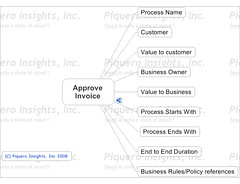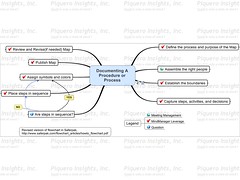I mentioned in an earlier post that there are actually two maps in a process map, the meta data and the process steps.
What I was driving at is kind of a mixture of project management and six-sigma. The following map is an example of what I would consider meta data for a process. This is important information to have about the process that wouldn’t be in the steps of the process.

I remarked to my audience that this map is more suitable to upper management discussions about the process. If you can’t articulate a value to the customer, why have the process at all.
You would normally attach or hyperlink important documents to this map. In this example I have hyperlinked to the process map for Approve Invoice. That’s why there is a little icon in the lower right of the central topic.I uploaded the map to Flickr. Click the map to go there and see a better image, many sizes are available.


